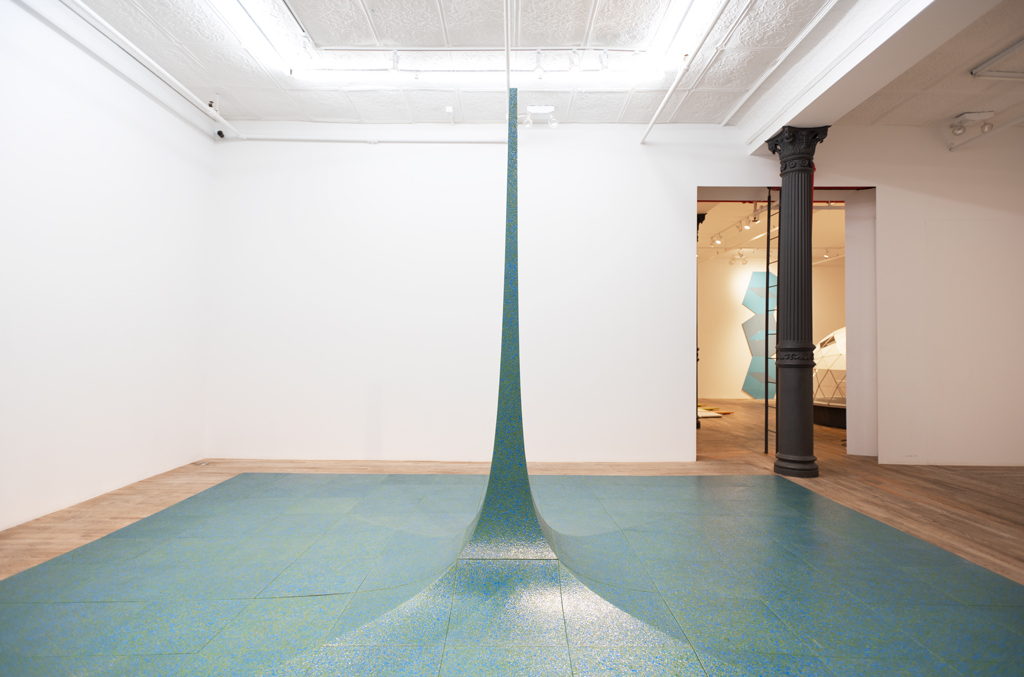[ad_1]
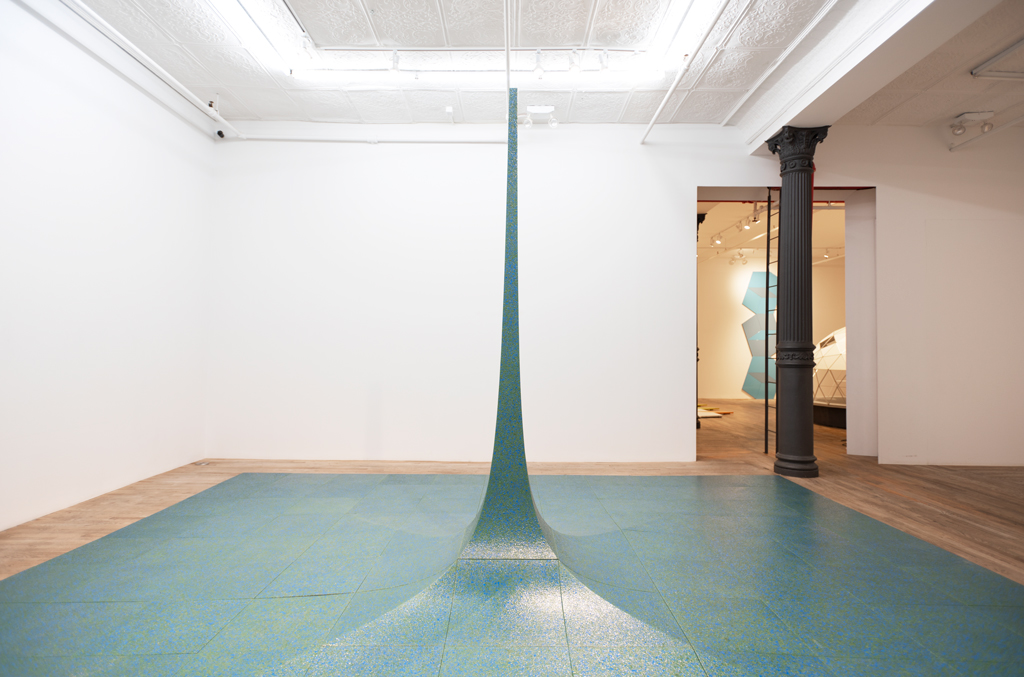
Bernard Kirschenbaum, Monument to the Earth, 1981, polyurethane on wood, installation view.
LISHAN LIU/COURTESY POSTMASTERS GALLERY
Bernard Kirschenbaum (1924–2016) began making sculpture in the mid-1960s, after several years as a modernist architect under the sway of Buckminster Fuller. He showed geodesic domes and room-filling sculptures of intricately tiled geometric panels in early exhibitions at Park Place Gallery and Paula Cooper Gallery in New York. After extensive shows in the United States through the 1970s, the focus of Kirschenbaum’s career shifted to Sweden, where he was a professor at the Swedish Royal Academy of Art in Stockholm. An extraordinary exhibition of his sculptures and installations at Postmasters Gallery, in Manhattan’s Tribeca neighborhood, is the first show of the artist’s work in the U.S. in nearly 40 years.
In late September, Kirschenbaum’s widow, the artist Susan Weil, spoke about his work and life at the Williamsburg studio they shared for 20 years. Weil met and married Kirschenbaum in 1957, after she had sought him out to build a dome studio for her in Stony Creek, Connecticut. Together they raised two children, Christopher Rauschenberg (Weil’s son from her first marriage, to the artist Robert Rauschenberg, which ended in 1952) and Sara Kirschenbaum. At 88, Weil continues to paint and publish, and will have work in “Bauhaus and America, Experiments with light and movement,” opening in November at the LWL-Museum für Kunst und Kultur in Münster. The following interview has been edited for clarity.
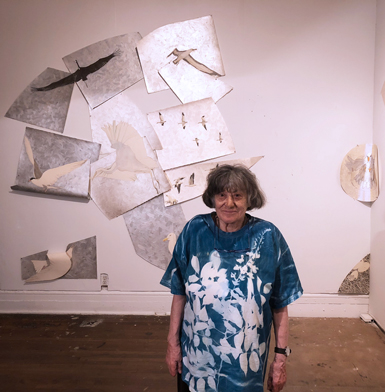
Susan Weil.
GREG ALLEN FOR ARTNEWS
Greg Allen: What is the best place to start understanding Kirschenbaum’s work? Is it the current show, his life, your meeting—where do you think?
Susan Weil: Bernie was in architecture school at Cornell, and it wasn’t too contemporary, so he moved to the Institute of Design in Chicago. He was studying there and met Bucky [Fuller] there, and was very taken by his thinking and his work. He was always very interested in science and technology, so he responded to that very much when he met Bucky. He moved to Boston and opened Geodesics, an architecture office with Bill Wainwright, and Bucky was the honorary president. The big work they did was for the government’s DEW Line domes [a network of radar stations across Northern Canada built in the mid-1950s], and that was a huge job, a very important job, but he didn’t want to work in relation to military anything. He didn’t believe in it. So he left his company, which he was a partner of, to work at Skidmore, Owings & Merrill, on architecture that wasn’t related to the military.
I met him because Dorothea Rockburne, who I knew from Black Mountain, I said to her, “I need a studio,” and she said, “I have this friend, Bernie Kirschenbaum, and he’s an architect, why don’t you meet him,” and that was that. Forget about a studio, he created our home, and he designed himself into it.
When I first met and married Bernie, he was definitely still an architect. He had another dome project he was trying to do, a universal dome which people could live in, and so he got this other job, and then it fell through, and that just hit him like a ton of bricks. And then he sort of slid into his sculptural activity.
Were you a practicing artist at that moment? Was he part of a community, surrounded by artists that lured him in, or did he have something he wanted to do, and art was the venue to do it?
He was always very fascinated by art, but his direction was more architecture. At that point, he discovered this gallery, Park Place Gallery. He met Forrest Myers, who he had known from this factory where he’d worked, and he had talked to him about the domes, and they had a dome show [in 1967]. That’s one that is in the [Postmasters] show, one of the three dome models from Park Place.
And then they said, We’re having a sculpture show in a couple of months, why don’t you do a sculpture for us? That was his first professional sculpture. It was three panels in intense color—red, green, and blue, and the edges were lights, on a platform. And from then on, for him, it was sculpture.
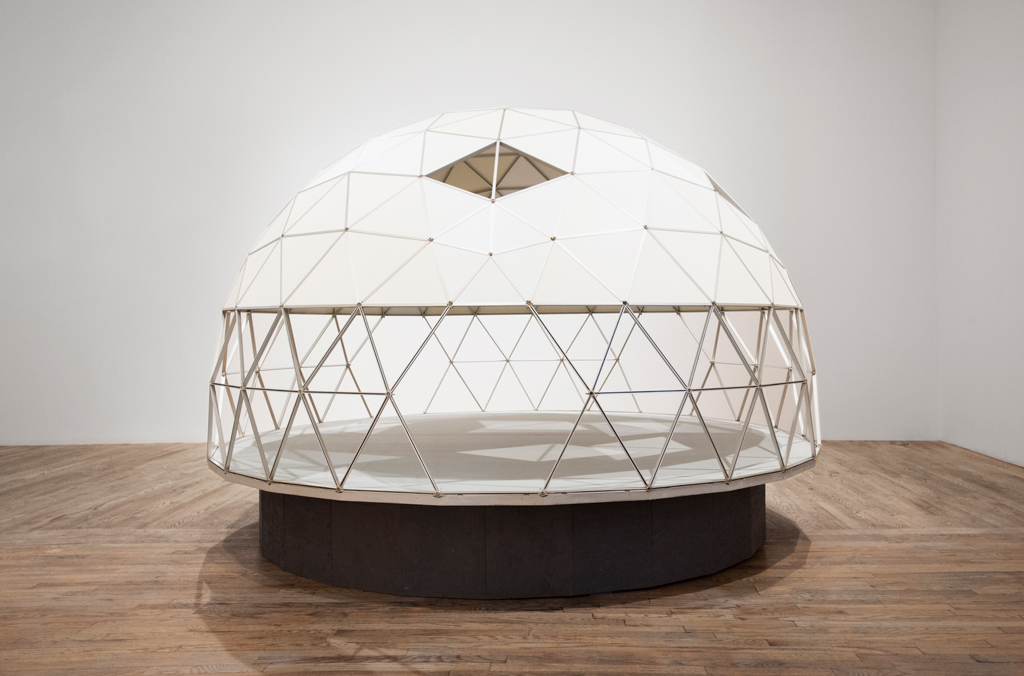
Bernard Kirschenbaum, Model Dome Cluster (1 Dome), 1966, masonite, plexiglass, aluminum, installation view.
LISHAN LIU/COURTESY POSTMASTERS GALLERY
Did he have an idea of what he would do, or did he say, “I’m going to be in a show, I have to make something.” How did he get there?
Even at Cornell, he had been involved with theater, and in art, and he was very interested in a geometric view. So immediately, then, with an opportunity to be a part of this gallery, he was thinking from this point of view, how he could make that work.
So I’m hearing that he had these geometric patterns—this sort of sense of that world, this mathematical, or geometric world, and the way that it works—that were already of an interest to him, and how could he realize that in the real world, as an object, or a sculpture, or a spatial experience, and that’s how he got into making what we call sculpture. What I’m amazed by is, we’re used to the idea of calling what he did as sculptural now, because we’ve come through Minimalism, and the artist’s mark, and having things fabricated, but at the time, that was still largely unheard of: that you could order a sculpture. That you could have something fabricated in a shop, and it would be a sculpture. Did he think about that much, or was it not a concern for him?
Well, it wasn’t that way with him, because he wanted to be a part of every step of it. He didn’t order something and then it came. He worked in all the materials, in the actual welding, and finishing, and this, that, and the other. He had to know everything about how things were made. No, he had a beautiful vision.
And that’s when he made the piece you saw, Two Element City (1969). There were two big pieces: Two Element City and Three Element City. And Patrick Lannan bought Three Element City, and then they destroyed it after [Lannan’s] death. Which just makes me furious; it was a major work.
That is the one related to the drawing [at Postmasters]—
Right, that’s part of it. Red/Blue/Brown. It was the kind of geometry that Two Element City is. At Paula Cooper’s gallery, it was on the floor and wall. And when Lannan bought it, Bernie installed it as ceiling and wall.
So he was still thinking of things in terms of space, a space someone would inhabit when he’s thinking of his sculptures. Was he thinking of components, a world of parts? Or is he thinking of a holistic thing that he would realize? Did that distinction matter to him?
I think the making of a pattern, and the elements of a geometric pattern, fascinated him. These pieces he made are now called Penrose Tiles, but he made and showed these patterns years before at Paula’s gallery. Bernie invented that pattern; he worked very hard on that. At one point, it was going to be the floor of our dome.
I don’t know if you know this work, 298 Circles (1976)? That was such a unique piece, and it was designed for the space, the lower floor of Max Hutchinson’s gallery, where it worked perfectly. Those were problems that Bernie adored, to work out spaces.
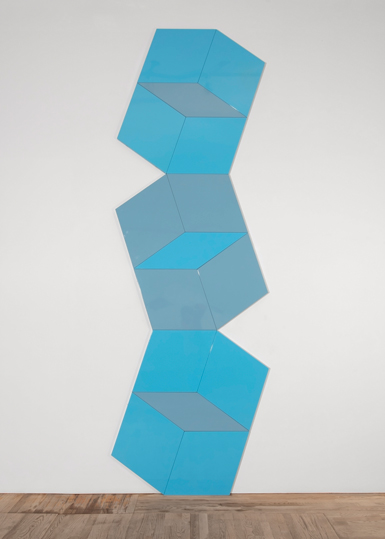
Bernard Kirschenbaum, Wall Column, 1969, painted steel, blue and grey, installation view.
LISHAN LIU/COURTESY POSTMASTERS GALLERY
How would he approach them? Would he start with the space, or take an idea and say, “How to I make it happen in this space?”
Bernie was such a complicated, interesting person. He had been through a lot in World War II. He was very traumatized by it, but he found his way in art, to get through. He was at Cornell when the war broke out, and then he was in the Army, and he was part of releasing the terrible news of these concentration camps. And he was Jewish, you know, so it was very tough on him. He went through a hell of a lot. But he was such an interesting man, he was so complicated in his thinking, but so wonderful. I’ve been very fortunate to have found such two challenging, interesting artists to spend my life with.
There’s a term that stands out from Bernie’s website—elegance—that comes from mathematics, where it refers to the beauty or logic or irreducibility of a solution. What was his relationship to elegance? Was it something he pursued, or is it something you’d just hope to find?
Well, he had this purity of vision, that was very important to him, and to everything around him. I had a friend who was kind of a regular person, who would say, “How can you care what your potholder looks like? How can he care?” Because we did. We cared about everything.
Now you’re saying “we.” Do you have an affinity for this elegance, too?
Yes, but different than Bernie.
I would say so, because your work always strikes me as much more intuitive, or as deriving from an internal source, whereas his, we think of math or geometry as somehow the world or the universe, that one is trying to make sense of. Yet you found something to share together in the potholder. How did that work? Did you have artistic discussion or arguments? Was it a challenge to divide up your time and space, to both keep your practices and work going?
Well, from the time I graduated from high school, I was a painter, and that’s all there was to it. But I also had two kids to raise, and chores to do, and stuff. But Bernie was much more self-oriented and self-needy. I was much more family-driven. When he was going to have a show or something, forget it. The kids couldn’t go to school. They were working on his pieces. We were all working on it. I wasn’t working on my pieces, I was working on his.
Bernie had a heart attack when he was in Sweden preparing for a Malmö Kunsthalle show [in 1984], a major show, and suddenly he was in the hospital. I called up his gallery, and asked, “Where’s Bernie, I can’t find him.” And they said, “Oh, he had a heart attack.” So Chris and I flew over there, and we worked on his pieces from then until the opening—and these were huge, huge pieces. They locked us in a factory, and we worked all night. We did that big arc piece [Deflection Arc, 1984] and several other large pieces. And then the doctor came to see the show and said to him, “Oh my God, I never would have let you work if I knew this is what you were doing.”
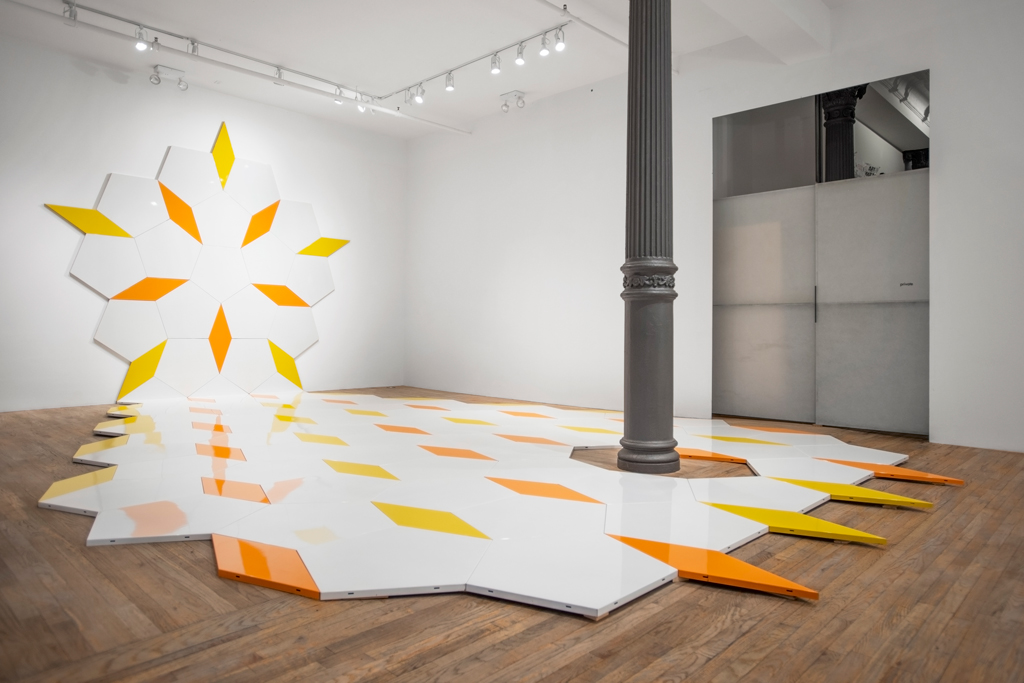
Bernard Kirschenbaum, Two Element City, 1969, painted steel, white, orange, and yellow, installation view.
LISHAN LIU/COURTESY POSTMASTERS GALLERY
How did he become interested in catenaries—I don’t know whether to call them an object, a shape, or a line—these arced forms he made in cable, wood, and then metal?
Bernie was fascinated by everything about science, and he just absorbed all kinds of interesting things coming into his worlds. A catenary was never arbitrary. It was the way something would hang. It was never an abstraction for him. It had a logic to it. He would have work that would theoretically go through a wall.
That makes me think of a work—or maybe it’s a series—which he called Self Portrait (1980), that is 13 concentric polygonal shapes of increasing diameter installed on the wall. How did he conceive of that as a self-portrait?
The first four pieces of it are in my living room. All the ones that aren’t on the wall are over here.
Oh my gosh, they’re gigantic. I can see how—did this start on paper?
Well, he did drawings, but he wanted them to be made of cherry, because he was a Kirschenbaum.
Maybe this is an instance of elegance, at least as a concept. I can see how these can start with a one line description—make a nested set of increasingly larger polygons—but then to realize them as objects becomes quite an ordeal.
The biggest ones are 10 feet [across], but they’re made in two halves, so you can move them. It’s all something else. It’s made of cherry wood, and of course, that’s his name, Kirschenbaum, cherry tree, that’s why he called it a self-portrait. Of course, they fit inside one another and grow, and that fascinated him. And it was an ordeal because what happened was, it was coming for a show at Max Hutchinson, the whole, huge thing. And then Bernie was working in the studio and put his thumb through the saw, so he called me up and said, “Come and get me, I’ve just cut off my thumb,” which he hadn’t, because it cut the other way. But we went to the hospital, and he couldn’t work, and there was no way to get the show done in time for the opening. And so Mike Boyd, who’s a wonderful artist, he drew all the shapes on the wall, and as soon as we could finish one, it went up. And on the closing day of the show, all the pieces were up.
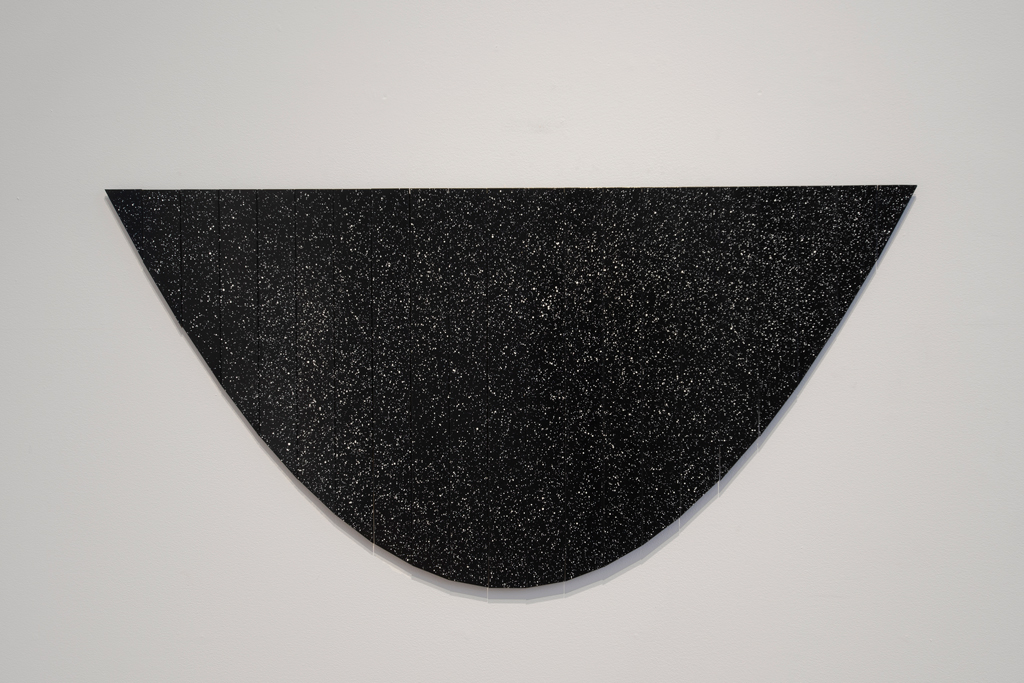
Bernard Kirschenbaum, Night, 1983, vitreous enamel on steel.
LISHAN LIU/COURTESY POSTMASTERS GALLERY
How did he find his way to Sweden?
I was showing in Sweden long before I met Bernie. I had a gallerist there, Anders Tornberg, who just believed in my work, and pushed it and pushed it, and gave me many shows. And we kept going back and forth, and we knew many Swedish artists. Then another gallery [Galerie Nordenhake in Stockholm] took Bernie on, and he was filling in for another teacher at the Technical College, and they asked him to teach. And we wondered, “How could we do it? We can’t live in two countries.” And he said, “Well, I will come home some summers, and you come over when you can.” And we lived like that for six or seven years.
He had a lot of shows there, and a big amount of students who loved studying with Bernie. Because there were not many abstract artists there. And another thing about art in Sweden: you’re not allowed to have ego; you’re supposed to be modest. And Bernie wasn’t that type. And they loved working with him because he let them stretch their minds. At the Technical School, he was doing happenings, all kinds of things.
You mentioned your daily poetry practice, which you call poem mumbles. How do you approach this practice? Do you see it as a routine, a meditation, a challenge?
Something I was always doing is putting together thoughts and images, so I would either start with an image and write words that went with it, or vice versa. It was a thing I did that I just fell for. It relates to everything going on in my life and my work, to thoughts, to relationships, to family. It just was a discipline that moved me very much.
When Bernie was sick, I stopped, because there were people in my house all day, every day, because he needed care. So I stopped, but by then I’d done maybe 40 years of them, or 50. Now I’m sorting them, to make sure they survive. I’m working with them in a different way, all day, every day. I’m working on accumulations of them, and I’m trying to divide them into a series of exhibitions and books.
Always when he had a major project going, I had to work on Bernie’s, but it wasn’t my way. It was like doing homework in a subject that wasn’t your major. The poems were my discipline.
You mentioned you became a James Joyce student, and I know you have produced several Joyce-related artist books. How did that happen?
First of all, when I was a kid, Joyce was my father’s favorite writer. And I didn’t know what he was talking about, but he’d read to us from Finnegan’s Wake or something, you know. I used to think, Oh, I love the way he feels about it, and I love the sounds; it was like music. Then when I was first working with Vincent Fitzgerald on the limited-edition books, he said, If we did a book together, what writer would you be interested in balancing [your images] with? And I said, James Joyce. And so I had to study. I studied all of Joyce, and made endless [notebooks] of working thoughts for the whole [of his] writing.
You have used the book as a medium or a form for a number of years, but I still come back to the work of these poems, that you said were often related to, or a response to, an image. What is this relation between a text and an image that’s interesting to you?
To perceive of something you have to visualize it. For me, working is putting together images that move you, and so on, but then you have to have a way to describe it to yourself. And it’s been marvelous. There are themes that go through my work for 20 or 30 years, but they take different forms. When I was a kid growing up on the Island [Outer Island, Connecticut], the horizon was a very powerful thing for me. My father, we were in a boat together and he said to me, “That’s not a straight line. That’s the edge of the earth,” and that stuck with me forever.
[ad_2]
Source link

